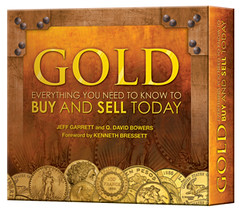
PREV ARTICLE
NEXT ARTICLE
FULL ISSUE
PREV FULL ISSUE
BOOK REVIEW: GOLD: EVERYTHING YOU NEED TO KNOW TO BUY AND SELL TODAY
Michael E. Marotta submitted the following review of the new book on Gold by Garrett and Bowers.
-Editor
A grammarian will insist that there is no such thing as “more perfect” (the U.S. Constitution to the contrary notwithstanding). A numismatist (at least an American one) will remind the grammarian that there are ten grades of Uncirculated. Those boundaries limit criticism of this excellent book. Anyone who learned their economics by reading Ludwig von Mises will find the occasional error, perhaps the “bagmarks” of our publicly-financed educational systems. That does not detract from the luster of this book's illustrations, the sharpness of its prose, or the rare presentation of so much information in such a compact form. The ten pockets of tipped-in ephemera relate generally to the nine chapters of narrative. In the pockets are:
The chapter titles are: “Gold: What is it and Why is it so valuable?”; “The Recent Gold Boom”; “Selling Your Gold”; “Buying Gold”; “Deal With the Experts”; “Avoiding Counterfeit and Altered Gold Coins”; “Quick Answers to Frequently Asked Questions”; “Glossary of Gold-Related Terms”; and “More Resources”. However, the chapter titles belie the wealth of related data assigned to each heading. For instance under “Buying Gold,” (the longest chapter, running 32 pages) in addition to the Ganz essay, the Bibliography, and Executive Order 6102, is a case study on grading Liberty Head Half Eagles. After all, when buying coins, grade can be more important than bullion value. While the emphasis throughout is on nominally common bullion coins, the lavish illustrations include the gold of Lydia, Syracuse, Carthage, and England, as well as Barber's “Amazonian” $20 of 1872 and the U.S. Assay Commission Medal of 1918. Setting aside the buying and selling of a commodity, this is also a pictorial of gold coins as a medium of fine art. Like all Whitman books, this one is priced to sell. At $12.95, it can be an easy gratuity for a bullion dealer to give a reliable client, and also be the best choice for the novice customer to buy. The slipcase displays well on the bookshelf and will protect this octavo for decades to come. Not so assured are the fates of the ephemera. Little things such they are destined to be lost, increasing the value of the survivors. This style of book is rare, the design intent being artistic, not merely utilitarian. More efforts like this would support books as an aesthetic medium. One reason that this little charmer is affordable is that it was produced in China. That fact, too, reflects the attractive gleam of gold.
There not much I can add to Mike's excellent review, except to second his motion that this is a great little book, both useful and attractive. I would recommend it to anyone holding, investing in, or selling gold in any form. The tables are extremely useful - it's like being given the keys to the coin dealer's castle. The weight conversion tables and tables such as "Melt values of Gold Jewelry and Scrap, per pennyweight" level the playing field for gold transactions. Buyers and sellers can "trust, but verify" what the other party is offering.
The short section on counterfeits is made very useful by the inclusion of charts listing the proper size, weights and tolerances of U.S. gold coins. The advice for readers is brief, but spot-on, including close-up illustrations of weak lettering, bubbles, tool marks and other tell-tale signs. As a bibliophile I appreciate the inclusion of a reproduction of the 1933 Executive Order ordering citizens to turn in their gold. It's properly marked "Reproduction" at the bottom. I've never seen a real one of these, so I wonder if the size is accurate. Could someone cut off the bottom margin and peddle the flyer as real? Anyway, congratulations to Whitman for taking a chance on an unusual format - I think this one works very well. -Editor Wayne Homren, Editor The Numismatic Bibliomania Society is a non-profit organization promoting numismatic literature. See our web site at coinbooks.org. To submit items for publication in The E-Sylum, write to the Editor at this address: whomren@gmail.com To subscribe go to: https://my.binhost.com/lists/listinfo/esylum All Rights Reserved. NBS Home Page Contact the NBS webmaster 
|
 "Gold: Everything You Need to Know to Buy and Sell Today" by Jeff Garrett and Q. David Bowers (Forward by Kenneth Bressett), 120 pages, $12.95.
"Gold: Everything You Need to Know to Buy and Sell Today" by Jeff Garrett and Q. David Bowers (Forward by Kenneth Bressett), 120 pages, $12.95.